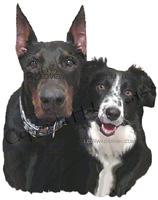When I was first learning how to train dogs, it was back in the 80’s. My first classes were with Dick Koehler. Through his tutelage, I learned how to train dogs using a method of force. If we are looking at quadrants, that would be positive punishment (which really isn’t positive at all) and negative reinforcement. Positive punishment was what we did to dogs when we yanked up on the choke chain when a dog didn’t obey the command, sit, {Read More}
A Dog’s Temperament
This quote is from the Temperament Test for Dogs website describing what temperament is. “W. Handel, German Police Dog Trainer, in his article, “The Psychological Basis of Temperament Testing,” defines temperament as ‘the sum total of all inborn and acquired physical and mental traits and talents which determines, forms and regulates behavior in the environment.’” That is the combination of Fixed Action Patterns and Learning abilities I described in an earlier blog post, and qualities that can be used in {Read More}
Trick Dog Champion
Here is the Trick Dog Champion Title video of my own dog, Australian Shepherd Dudley. I’m very proud of this accomplishment, and for the fun I’ve had with Dudley as we’ve trained for this title. But the fun doesn’t stop here. We are still training new tricks! If you’re interested in training your dog to do tricks, contact me! I’m a Certified Trick Dog Instructor and would be glad to work with you towards your trick dog training goals. Helen {Read More}
Rolling Rolling Rolling
I’ve trained my Australian Shepherd, Dudley, through four trick titles: Novice, Intermediate, Advanced, and Expert. We are now on the border of our final title, Trick Dog Champion. Teaching tricks to your dog, whether to achieve titles or just for fun, is an excellent way to bond and have fun together. Trick training can be done inside on a rainy day or outside on a beautiful day. Some tricks require props and some don’t. Ball rolling is a great outdoor {Read More}
Clicker Training To Salvage A Behavior
A clicker is a tool used to communicate exactness to a dog. It’s the bridge between the moment a dog executes a behavior to the reward he gets after the click. It’s a communication device. Always pair the click with a reward. Otherwise, your clicker will soon become useless. Besides building behaviors, clicker training can salvage them. Here is a 30-second example of how helpful a well timed click can be. And be assured, Dudley got a treat after the {Read More}


